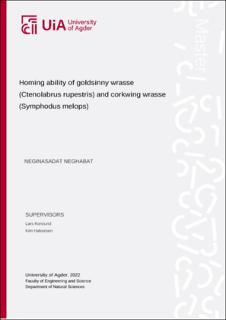| dc.description.abstract | Wrasse family (Labridae) are widely used as a cleaner fish in salmonid aquaculture to remove
the sea lice infestation. Goldsinny wrasse and corkwing wrasse are the most used wrasse fishes
in the aquaculture industry in Norway and since that the demand for wildly catching goldsinny
and corkwing wrasse was increased and in 2017 it was the pick of the catching wrasse. In 2011,
the first wrasse measurement regulation was established. After that, the fishery specified size
limitations for all wrasses. The size limit for goldsinny wrasse is 11 cm, and for corkwing
wrasse is 12 cm and with these size limits fishers can release them back to the sea, fishers may
not always release fishes in the capture site. Homing behavior is the ability of fish to return at
least one time to the same area that they recaptured. In my thesis, I examine the homing ability
of goldsinny wrasse and corkwing wrasse by translocating 221 goldsinny wrasse and 116
corkwing wrasse which had been tagged earlier, to new locations 300m and 400m along the
shoreline from their home and around the island with 400m far from their home and some of
them released at the pier as a control group. In this study, the impact of the body length and sex
in both species were tested as well. After translocation was done by detecting goldsinny wrasse
and corkwing wrasse at the pier I observed that 90% of all goldsinny wrasse were translocated
in 300m and 400m were returned home but 10% of them manage to return from the island.
Among the corkwing wrasse, 10% of them return home from 300m and 400m from their home
and there were no corkwing fish that returned from the island. In addition, goldsinny and
corkwing had different return times. Goldsinny is faster than corkwing and goldsinny takes a
long time to return home from the island, and corkwing takes more time to return from 400m
distance from their home. In conclusion, for fisheries and management, my study suggests that
both species can be released up to 400m along the same shoreline and most will still return to
the home location. On the other hand, it is unclear what their fate is if we release them in open
waters. Also, goldsinny wrasse showed homing ability when they returned across the open,
deeper waters to go home from the island. In future studies, it is suggested to translocate
goldsinny and corkwing to open waters in order to examine the homing ability. | |
